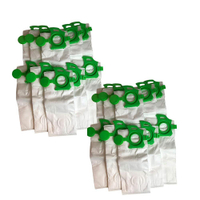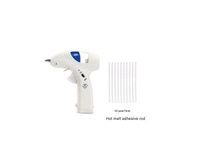How to make a no-sew face mask at home
Here’s how to make a no-sew face mask at home with a T-shirt, plus DIY masks using a vacuum bag or dish towel.

Many are wondering how to make a no-sew face mask at home with materials they have handy. And now that health officials are recommending we wear coverings in public, it could be useful to know how to make a face mask at home.
According to researchers from Cambridge University, vacuum cleaner bags (or HEPA bags) and dish towels are among the most effective household materials against small, airborne virus particles. Cotton t-shirts and pillow cases are slightly less protective but provide a necessary breathability, making them another suitable foundation for a DIY face mask.
And should you have more than one of these mediums available, you can pair them together to make, say, a washable cloth face mask with disposable HEPA bag liners inside.
- Where to buy Clorox wipes: These retailers have stock
- These are the Coronavirus drive through testing locations in your state
- Plus: The best food delivery services
Before you learn how to make a face mask, you’ll want to get out a sewing machine or sewing kit, scissors and elastic. If you don’t have these DIY materials at your disposal, there could be miscellaneous objects in junk drawers, storage closets and medicine cabinets that work when you can’t find traditional crafting supplies. Hair bands, bra straps or the waistband of old sweatpants could replace elastic thread, for example. Some people have even been cutting up pantyhose or tights.
If you don’t have a sewing kit or machine, there tutorials for how to make a no-sew face mask with just a couple of everyday materials.
We’ll show you a few different approaches to how to make a face mask, but you should be aware of the controversy surrounding the use of homemade personal protective equipment first.
Experts were divided as to whether a homemade mask is an effective defense against airborne germs, and whether you should wear a face mask at all. The CDC revised its recommendation, saying we should use cloth face coverings to help slow the spread. Studies have also shown that mask-wearing could be a viable measure when paired with frequent hand-washing and stringent social-distancing.
Sign up to get the BEST of Tom’s Guide direct to your inbox.
Upgrade your life with a daily dose of the biggest tech news, lifestyle hacks and our curated analysis. Be the first to know about cutting-edge gadgets and the hottest deals.
Certain areas have even mandated the use of face masks. In parts of California, it's not optional for residents to leave home without a cloth covering over their mouth or nose. Governor Andrew Cuomo of New York also told CNN’s Anderson Cooper that “it couldn’t hurt from a public-health point of view,” and recommends that people in COVID-19 hot spot consider face masks. New Jersey residents need to wear a mask when in any essential retail stores, like grocery stores, too.

Should you make your own face mask?
A homemade face mask can capture small air particles, but it is not up to par with medical standards and should not be used in place of a N95 mask in environments with a high-risk of viral transmission. For fabric options, you'll also need to know how to clean a face mask.
However, if you’re wondering how to make a face mask to donate to emergency medical workers battling the coronavirus, Dr. Ryan Southworth, an emergency medicine physician in Arizona, believes HEPA vacuum bags make quality face masks. It hasn’t gone through clinical testing, but Dr. Southworth believes it’s the best we can do at home. Be sure you wash your hands and transport the masks in a clean state for donation.
Despite the stigma of wearing a face mask, you’re allowed to take individual measures that make you feel more secure while running essential errands. So if having a homemade filter around your mouth and nose eases your fears, go ahead and check out these tutorials on how to make a no sew face mask, or sewn one if you have a machine.
Important: The WHO reminds us that homemade masks are only effective when used in combination with frequent and proper hand-washing.
How to make a no-sew face mask with a T-Shirt and scissors: Method 1
After updating its guidance on face masks, the CDC released a simple hack for how to make a no-sew face mask. All you need is a pair of a scissors and old T-Shirt, unlike the no-sew tutorial below that requires elastic hair bands. This kind of mask is secured to your head with fabric rather than elastic, so before you go outside make sure you securely tie it on your face or ask a home member to help you. We also recommend using a medium-sized T-shirt if you have one, otherwise you might need to make some adjustments to your tie string lengths.
- Step 1: Cut the T-Shirt along a straight line, 7 to 8-inches above the bottom hem.
- Step 2: Cut a rectangle from the right side of the fabric, about 7-inches long and 5-inches tall.
- Step 3: Cut the tie strings where the right side of the fabric is still attached.
- Step 4: Tie strings around your neck and over the top of your head.
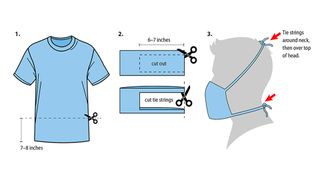
How to make a face mask with a vacuum cleaner bag
• HEPA vacuum bag
• Needle and thread (or sewing machine)
• Hot glue gun and hot glue
• Elastic tape (at least 11 inches, pre-washed)
• Pipe cleaner or other thin, malleable wiring
• Stencil, cut out from pattern
• Pencil or marker
• Scissors
You want to make sure you’re using a washable, cloth vacuum cleaner bag with a high filtration value. SuperStitchSewing, a popular YouTube textile resource, recommends the Miele U bag or Envirocare bag. You’ll want to check for a HEPA label, which means the bag’s material traps 99.97% of dust and pollen. Download and print this mask pattern to get started. When arranged properly, the stencil lets you turn your vacuum cleaner bag into four separate face masks.
- Step 1: Cut the corners of the vacuum bag to flatten its surface
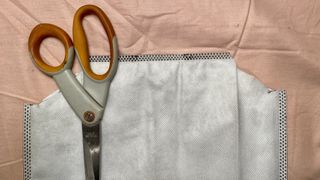
- Step 2: Line up stencil so the top border aligns with the vacuum bag’s edge. Trace stencil with pencil or marker onto the vacuum bag.
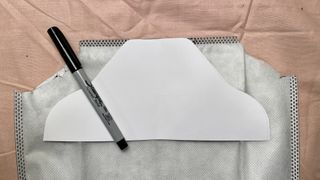
- Step 3: Cut out the mask and open up the fold.
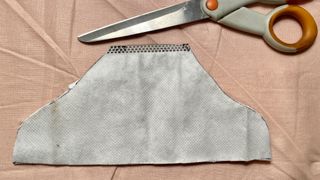
- Step 4: Pull up the top layer from the bottom half up the mask and fold it over the top half. Bend pipe cleaner in half and apply hot glue to one side. Attach the pipe cleaner to the bottom edge of the mask.

- Step 5: Return the folded top layer to the bottom half of the mask. Stitch the along the top and bottom edges of the mask to join the layers.

- Step 6: Cut the 11-inch elastic strip in half. Stitch the ends of the elastic strips to the corners of the mask, with one piece for the top and one piece for the bottom.
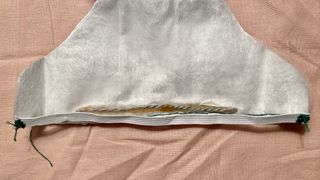
- Step 7: Fold the mask in half and make sure the top and bottom halves align. Stitch along the sides of the mask to finish.

HEPA Cloth Bags (20 pack): $22 @ Home Depot
These HEPA vacuum bags from Home Depot can be turned into face masks following the steps above. You should be able to use your stencil 4 times per bag, meaning you can make 80 masks at home.
Wireless Hot Glue Gun kit: $20 @ Newegg
This wireless hot glue gun kit comes with 10 glue sticks and will suit your crafting needs. Use it to make a face mask and other DIY projects while stuck at home.
How to make a face mask with a dish towel
• Needle and thread
• Scissors
• 20 x 20 inches of 100% cotton fabric, like a dish towel (pre-washed)
• 4 elastic strings at least four inches long (pre-washed)
While it’s helpful to have a sewing machine to make this dish towel face mask, you can also easily hand-sew it. Start by finding some tightly-woven cotton fabric. Research shows it’s better to use 100% cotton versus a cotton-polyester blend. A dish towel ranks third under a surgical mask and a vacuum cleaner bag as the most effective against particles.
You’ll also need elastic strings, which you can take off of various common household items. Try bra straps, bathing suit straps, hair ties or thick rubber bands. Then, download and print this template provided by The New York Times, which created the instructions below.
- Step 1: Cut out four pieces of fabric using the template.
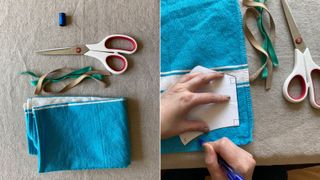
- Step 2: Take two pieces and sew the curved sides together to create the front side of the mask. Repeat with the other two pieces for the back side of the mask.

- Step 3: Place one side of the mask on a table, seam-side down. Lay the four elastic strings on the corners, leaving the ends peeking a little over the cloth edge. Sew the ribbons in place.
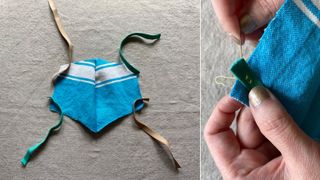
- Step 4: Pull all four ribbons over to the right side. Lay the other side of the mask on top, seam-side up, to sandwich the ribbons.

- Step 5: Sew the top, left and bottom sides of the mask. Leave the right side (where the ribbons are) unsewn.
- Step 6: Turn the mask inside out by pulling the ribbons through the hole on the right side. Now, sew the right side to close the hole.
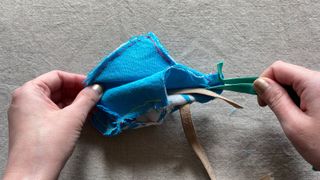
- Step 7: Tie the elastic strings together to fit over your ears. Adjust as necessary.

Cotton Fabric Dish Towls (8 pack): $17 @ Home Depot
If you follow the steps above, you can make a face mask at home using these 100% cotton fabric, machine-washable dishcloths.
How to make a no-sew face mask with a T-shirt
• Scissors
• T-shirt (pre-washed)
• Two elastic loops (pre-washed)
T-shirts rank just under dish towels in effectiveness against particles. Both a cotton blend T-shirt or 100% cotton T-shirt will work in these two methods. As far as elastic strings go, the first method uses two loops, which could be hair ties or thick rubber bands.
The first method comes from the Japanese Creations blog. They use a handkerchief but not that many have one of those lying around, which is why we’ve adapted it to a T-shirt. Here’s how to make a no-sew pleated face mask:
- Step 1: Cut out an 18x18 square of fabric from the T-shirt and lay it down.

- Step 2: Fold the top to the center. Fold the bottom to the center. Then, flip it over.
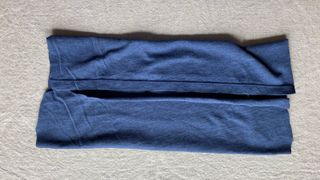
- Step 3: Fold the top to the center again. Fold the bottom to the center. Then, flip it over.
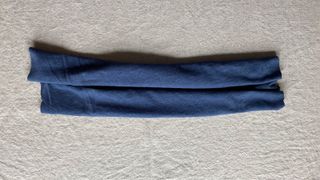
- Step 4: Put an elastic loop through each end. Fold the sides over.

- Step 5: Place the folded side over your face. Put loops over your ears.
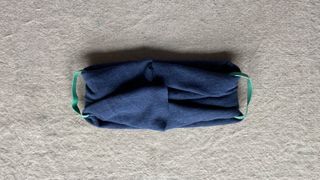
How to add a nylon layer over a face mask
An easy homemade face mask hack can increase the effectiveness of your mask. A recent study by researchers at Northeastern University found a way to make those homemade cloth masks even more effective against small air particles, like this that may carry COVID-19. All you need is pantyhose or nylon stockings.
Just cut a ring of material, about 8 to 10 inches tall, from one leg on a pair of pantyhose. Then place the ring over your head and pull down over your mask, to create a tight fit to your face.
- Best bread recipes: Quick and easy ways to make bread at home
- All the coronavirus drive through testing locations by state
Kate Kozuch is the managing editor of social and video at Tom’s Guide. She covers smartwatches, TVs and audio devices, too. Kate appears on Fox News to talk tech trends and runs the Tom's Guide TikTok account, which you should be following. When she’s not filming tech videos, you can find her taking up a new sport, mastering the NYT Crossword or channeling her inner celebrity chef.
-
geh12 DO NOT use vacuum bags - they contain glass particles. Use only filters that are safe for humans.Reply -
jonazthemechanic STOP SPREADING MISINFORMATION - These comments about fiberglass in vacuum bags are totally false. Please people if you are going to spread information around the web at least do a bit of research first. Have some sources to submit with your post. It is even more important in times like these when these things could be life saving. Here is a video from experts in the vacuum industry who have thoroughly explored this subject . This video also links to manufacture statements on the matter MSDS safety data sheets for various filters etc.Reply
vmYt_wtaLCkView: https://youtu.be/vmYt_wtaLCk -
COLGeek Reply
Thanks for sharing.jonazthemechanic said:STOP SPREADING MISINFORMATION - These comments about fiberglass in vacuum bags are totally false. Please people if you are going to spread information around the web at least do a bit of research first. Have some sources to submit with your post. It is even more important in times like these when these things could be life saving. Here is a video from experts in the vacuum industry who have thoroughly explored this subject . This video also links to manufacture statements on the matter MSDS safety data sheets for various filters etc.
vmYt_wtaLCkView: https://youtu.be/vmYt_wtaLCk
